Radiator
1. On turbocharged models, loosen the clamps securing the air intake pipework and jet muffler assembly to the airflow meter and turbogenerator. Unscrew the bolt of the assembly installation hangers on the front panel of the body, disconnect the breather hose from the valve. Remove the assembly and plug the inlet of the air flow meter and turbogenerator with a rag.
2. On all vehicles, remove the left front engine protection.
3. Drain the coolant from the cooling system by disconnecting the lower radiator reservoir hose.
4. Disconnect the upper hose of the radiator tank and the hose of the expansion tank. Remove the expansion tank hose from the radiator (photo).
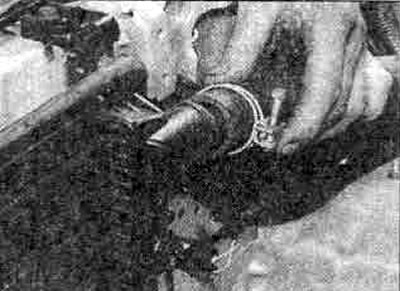
9.4A. Disconnecting the upper hose from the cross flow radiator

9.4V. Disconnecting the expansion tank hose
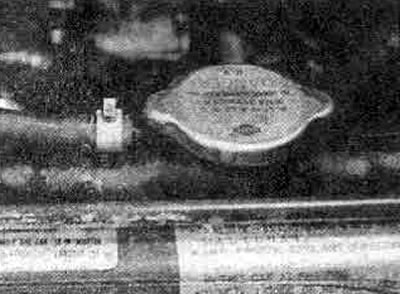
9.4C. Connections between expansion tank hose and vertical flow radiator
5. On vehicles with automatic transmission, loosen the clamps and disconnect the two flexible hoses from the radiator transmission fluid pipes; Mark each hose to ensure proper connection during assembly. Clog pipes and hoses.
6. On all vehicles, disconnect the negative battery cable.
7. Disconnect the electrical wiring of the thermal switch and the electric cooling fan motor on the radiator (photo).

9.7A. Disconnecting Thermal Switch Wiring - Crossflow Radiator Shown

9.7V. Disconnecting the electric cooling fan wires
8. The radiator is secured in each corner with a rubber pad. The upper fastenings are bolted to the front panel of the body, the lower ones are fastened with a nut (photo). Remove the radiator and cooling fan. On Executive models, the air conditioning condenser will remain in its own installations, in the front panel of the body.

9.8A. Unscrew the top fastening of the radiator tank...

9.8V....and bottom mount
9. Unscrew the screws and nuts securing the radiator to the front panel of the body and remove the radiator assembly from the engine compartment (photo).

9.9. Removing the Heat Sink Assembly (cross flow) and cooling fan

Pic. 2.9. Checking the radiator cap valve
10. If required, the cooling fan and shroud can be removed from the radiator (photo).
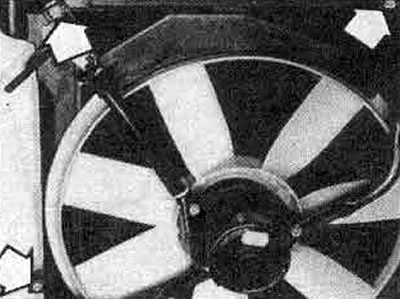
9.10. Remove mounting bolts (marked with arrows), to separate the radiator from the cooling fan
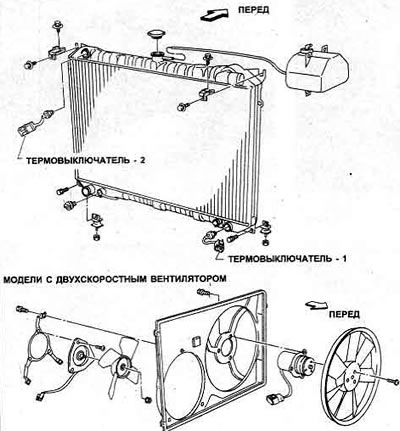
Pic. 2.10 Vertical flow radiator and electric cooling fan
11. If the radiator has been removed due to a clog causing overheating, then try back flushing or, in severe cases, use a radiator cleaner strictly in accordance with the manufacturer's instructions.

Pic. 2.11. Vertical flow radiator and electric cooling fan
12. Use a soft brush or compressed air to clean the radiator from insects and leaves.
13. Minor radiator leaks can be repaired with a special sealant. In case of serious leaks, it is best to contact a specialist.
14. When replacing the radiator, make sure the new one is the same type.
15. Check the condition of the fasteners, replace them if necessary (photo).
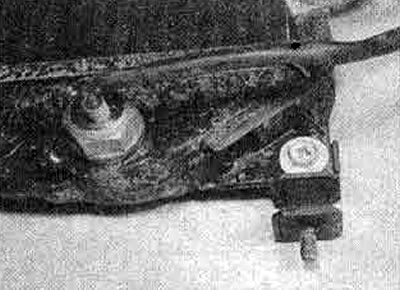
9.15. Radiator tank lower mount (with vertical flow) and thermal switch
16. Installation is carried out in reverse order. But before tightening the fastening nuts and screws, carefully check that the radiator is correctly installed in place (photo).
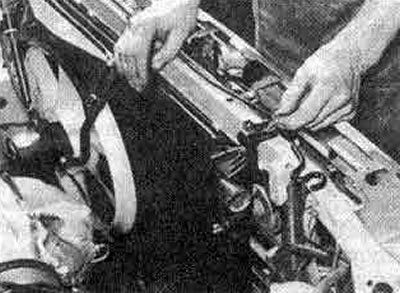
9.16. Place the radiator correctly before compressing the fasteners
17. Prime the cooling system as described in Chapter 5 of this Section. On vehicles with automatic transmission, top up the transmission fluid level as described in Section 7.
Radiator cap
18. The cover must be cleaned and inspected each time after removal. Check that the sealing surfaces are clean and undamaged and that they are properly aligned with the location on the radiator. Check the valve to ensure it opens smoothly (pic. 2.9); the valve must immediately return to the closed position after being released.
19. The lid can be checked using a lid leak tester (cooling system tester). When applying pressure, the lid relief valve must be closed until the specified pressure is reached at which it should open.
20. If there is any doubt about the correct operation of the cover, it must be replaced.
21. If the cover must be replaced, check that the new one is of the correct type and specifications; they are marked on the lid warning label (silver on pre-July 1988 models, yellow on later models).
Expansion tank
22. With the engine and radiator cold, remove the radiator cap, disconnect the expansion tank hose from the radiator filler neck (photo).
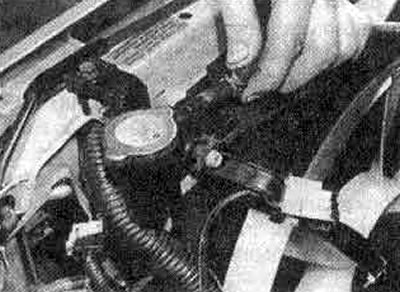
9.22 Loosen the clamp and disconnect the expansion tank hose from the radiator
23. Unscrew the bolt from the tank, remove the tank with the hose.
24. Drain the remaining refrigerant from the reservoir and rinse it with fresh water. If the tank is leaking, it needs to be replaced, but before doing so, try to repair it using similar material and suitable adhesive.
25. Install the tank and tighten the mounting bolts.